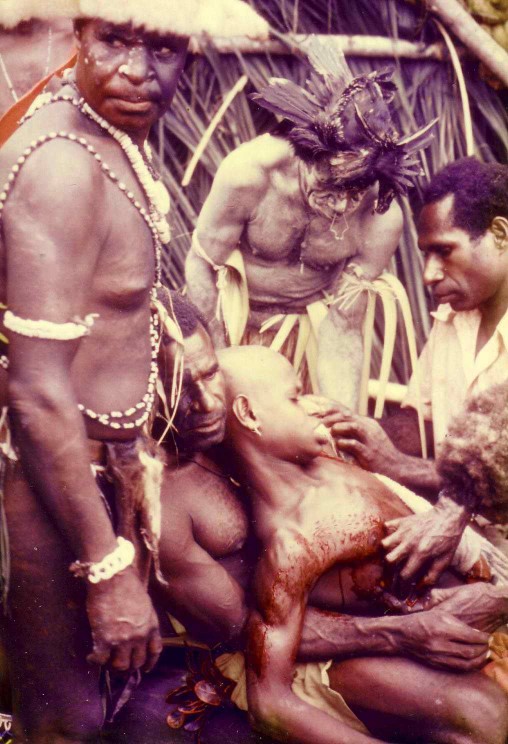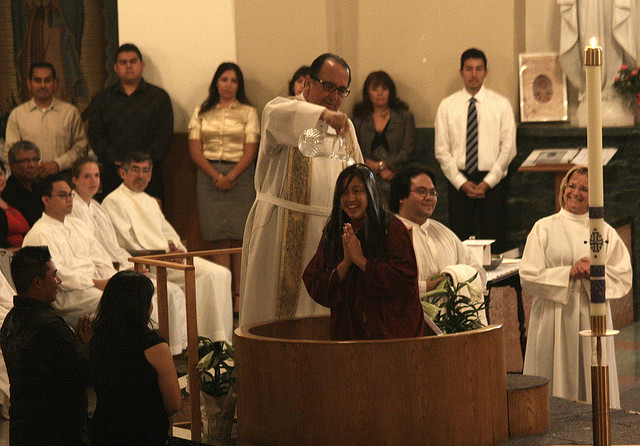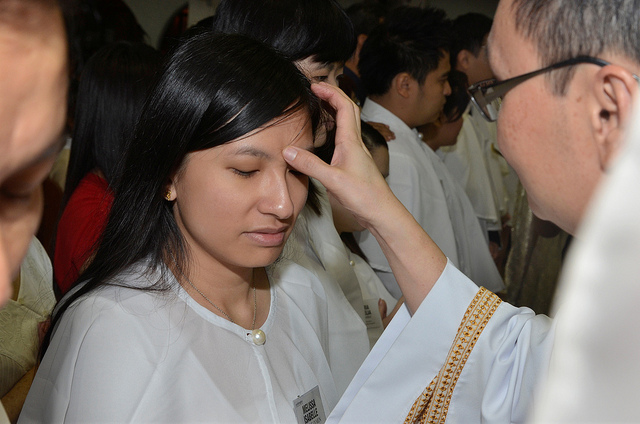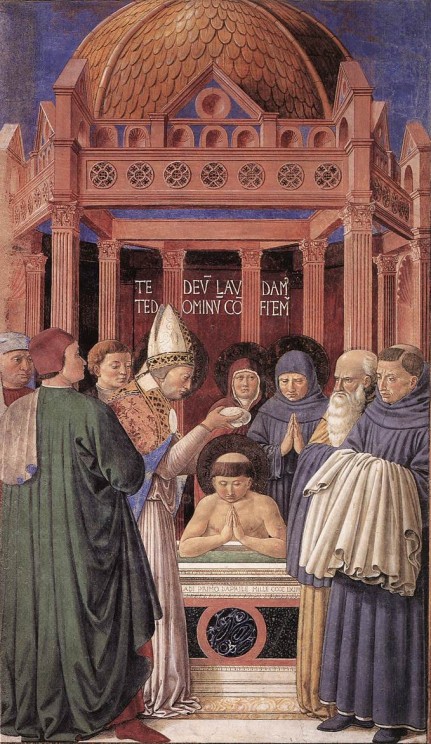In his study, sociologist David Yamane found an interesting correlation between the type of catechetical sessions used in the Rite of Christian Initiation of Adults process (which an adult who wants to enter the Catholic Church undergoes) and the socioeconomic standing (SES). He found that the lower the SES of the parish, the more they rely on hierarchical and passive pedagogies such as question and answer and lecturing. The higher the SES, the more diversity in their teachings, with more focus on participatory and engaging pedagogies such as liturgy and prayer and discussion.

Download a jpg or pdf of the infographic.
David Yamane teaches sociology at Wake Forest University. His primary scholarly interest is the sociology of organized religion, particularly Roman Catholicism in the postwar United States. His publications include The Catholic Church in State Politics: Negotiating Prophetic Demands and Political Realities (2005), Real Stories of Christian Initiation: Lessons for and from the RCIA (2006), and Religion in Sociological Perspective (2011). He is author of Becoming Catholic: Finding Rome in the American Religious Landscape.
Subscribe to the OUPblog via email or RSS.
Subscribe to only religion articles on the OUPblog via email or RSS.
The post Catechetical session comparisons [infographic] appeared first on OUPblog.

By David Yamane
For many Catholics in America, waking up in the morning to find no news about the church is a relief. They won’t have to deal with stories about the lingering stench of the priest sexual abuse scandal, the consolidation of parishes and closing of schools, controversy over Catholic hospitals and the loss of Catholic youth, fewer and older nuns and more and younger “nones.”
But what if no news was not the only good news? What if Catholics turned on their TVs and opened their papers on Easter Sunday and heard some real good news instead?

Family watching television 1958. Image credit: CC 2.0 via Flickr.
At Easter Vigil Masses on Saturday night, 19 April, something truly remarkable will take place. Tens of thousands of adults in thousands of parishes across the United States became Catholic. For most of them, this rite of passage is the climax of a months- (and in some cases years-) long process of formation called the Rite of Christian Initiation of Adults (RCIA).
As I have written previously, the implementation of this modernized ancient process of initiation is an excellent example of the contemporary re-invention of rites of passage and a fruitful legacy of the Second Vatican Council. It is a Catholic success story.

Sign reserving pews for the Catechumens. Photo by John Ragai. CC 2.0 via Flickr.
Although based on a single, universal ritual text, the way the RCIA process is implemented differs from parish to parish. We do well to remember a variant on Tip O’Neill’s quip that “all politics is local.” All Catholicism is local. In some parishes we find elaborate and beautiful rituals, rich with fragrant oils and soaring hymns and full body immersion in the waters of baptism. In some parishes, we see minimalistic ceremonies that strain the use of the term ritual.
Regardless of the quality of the celebration, however, through the sacraments of initiation—baptism, confirmation, and Eucharist—individuals become Catholic. When the officiating minister speaks the words and performs the actions of the sacraments—“I baptize you…” and “Be sealed…” and “Receive the Body of Christ”—from the perspective of the church, they have the intended effect. It does not matter if the priest says the words excitedly, sincerely, or in a monotone while yawning under his breath. It does not matter if a team of 20 catechists and thousands of parishioners welcome the new Catholic warmly and profusely, or if a single deacon rushes through a minimalistic ceremony while a few dozen assembled individuals wait impatiently for communion. It does not matter if the symbols of the initiation ceremony are rich or sparse. An individual who receives the sacraments of initiation in a Catholic Church is a Catholic. The individual now can check the “Catholic” box, join a parish, receive communion, get married in the church, and so on.
This fact reminds us that, at the same time that all Catholicism is local, we can also say that no Catholicism is only local. Without the universal church, there would be no RCIA process in local parishes. The Vatican II document Sacrosanctum Concilium (promulgated in 1963) led to the editio typica of the Ordo Initiationis Christianae Adultorum (issued in 1972), which led to the vernacular typical edition of the Rite of Christian Initiation of Adults (published in 1988), which has gradually been implemented in US parishes. Understanding this movement from universal to local is important. I think of this as being like the image on the cover of Pink Floyd’s album, “Dark Side of the Moon.” The album cover shows a beam of white light hitting a triangular prism, which refracts it to create a rainbow of colors. The culture and resources of local parishes do act as prisms, but without the light, you have no rainbow.
With unprecedented opportunities to choose a religion (or no religion) and to choose how to practice that religion (or not practice), the fact that tens of thousands of people still voluntarily chose Catholicism again this year is indeed good news for American Catholics.
David Yamane teaches sociology at Wake Forest University and is author of Becoming Catholic: Finding Rome in the American Religious Landscape. He is currently exploring the phenomenon of armed citizenship in America as part of what has been called “Gun Culture 2.0″—a new group of individuals (including an increasing number of women) who have entered American gun culture through concealed carry and the shooting sports. He blogs about this at Gun Culture 2.0. Follow him on Twitter @gunculture2pt0.
Subscribe to the OUPblog via email or RSS.
Subscribe to only religion articles on the OUPblog via email or RSS.
The post Easter rites of initiation bring good news for American Catholics appeared first on OUPblog.

By David Yamane
“It has often been said that one of the characteristics of the modern world is the disappearance of any meaningful rites of initiation.”
Mircea Eliade made this comment in his 1956 Haskell Lectures on the History of Religions at the University of Chicago (subsequently published as Rites and Symbols of Initiation). The qualifier meaningful in Eliade’s statement is significant, because something so fundamental to human societies (across cultures and over time) as rites of initiation do not simply melt into air, modernity notwithstanding.

Initiation ritual along the Sepik River in Papua New Guinea in 1975. Photo by Franz Luthi. CC BY-SA 3.0 via Wikimedia Commons.
Contemporary ritual studies luminary, Ronald Grimes, highlights a unique and contradictory aspect of Western industrialized societies when it comes to initiation, one perhaps implied by Eliade. “Initiation goes on all the time,” Grimes writes in his book, Deeply Into the Bone: Re-inventing Rites of Passage. But we lack “explicit or compelling initiation ceremonies.”
The centrifugal forces of modernity have rendered the initiation that does take place in Western industrial societies more diffuse, haphazard, individualized, and even sometimes only imaginary. In the face of this, some communities are attempting to create or re-create rites of passage that are mindful and intentional.
Perhaps not surprisingly, then, less than a decade after Eliade’s lectures, the leaders of the Roman Catholic Church meeting at the Second Vatican Council (1962-1965) called for a restoration of the “catechumenate”—the ancient process for ritually initiating adults. As I noted yesterday, this culminated in the publication in 1972 of Ordo Initiationis Christianae Adultorum, subsequently translated into English in 1988 as Rite of Christian Initiation of Adults.
In his work on re-inventing rites of passage, Grimes does not mention the Rite of Christian Initiation of Adults (RCIA), but he could have. In “returning to the sources” in the ancient church for an earlier model of initiation (what French theologians call ressourcement), the creators of the contemporary RCIA engaged in the very process of reinvention that Grimes calls for.
When fully implemented, the RCIA process takes those considering becoming Catholic on a journey through four distinct periods of formation which are demarcated by three ritual transitions.
Period 1: Evangelization and Precatechumenate
The opening stage of the RCIA process is intended to introduce individuals to the Catholic faith and to answer questions about it. Also during this period individuals are paired with sponsors, members of the church who will accompany the individual on their journal toward initiation.
Ritual Transition 1: Rite of Acceptance into the Order of Catechumens
Those who decide to continue in the RCIA process go through this first of three major ritual transitions. During a liturgy individuals are asked to affirm their acceptance of the Gospel of Christ and the assembly is asked to affirm their support of the candidates. The passage to the status of “catechumen” is then ritually enacted by the priest, catechist, or sponsor tracing the sign of the cross on the forehead (and often also the ears, eyes, lips, chest, shoulders, hands, and feet) of the candidate.
Period 2: Catechumenate
This is the main time of formation for those seeking initiation. The purpose of this period is to give catechumens “suitable pastoral formation and guidance, aimed at training them in the Christian life” through catechesis, community, liturgy, and service (RCIA, no. 75). Once catechumens are ready to receive the sacraments of initiation they must publicly declare this and go through a ritual transition to become one of the “elect.”
Ritual Transition 2: Rite of Election
Typically held the first Sunday of Lent and presided over by the bishop, this ritual brings together individuals in the RCIA process from the entire diocese so that for the first time the candidates are able to see and experience the church writ large. In this rite, God “elects” those catechumens who are deemed ready to take part in the sacraments of initiation and who affirm their desire to do so. The candidates’ names are enrolled in the diocesan “Book of the Elect” which is countersigned by the bishop who declares them ready to begin their final period of preparation before initiation.
Period 3: Purification and Enlightenment
This period focuses on spiritual preparation for the rites of initiation and coincides with the 40 days preceding Easter, known as the season of Lent. As part of their spiritual cleansing, the elect undergo three public “scrutinies” which typically involve prayer over the elect and an “exorcism” enacted by a laying on of hands by the presider. The elect are also ritually presented the text of the Nicene Creed and Lord’s Prayer. At the conclusion of this period, the elect undergo the most significant ritual transition: the reception of the sacraments of initiation.
Ritual Transition 3: Reception of the Sacraments of Initiation
This moment of incorporation—literally becoming part of the body of the church—normatively and most often takes place during the Easter Vigil, what Augustine called “the mother of all holy vigils.” In and through this ritual, individuals receive the sacraments of initiation (baptism, confirmation, and eucharist) and in doing so become Catholic.
Period 4: Mystagogy
This is sometimes called the period of “post-baptismal catechesis” because it seeks to lead the newly initiated more deeply into reflection on the experience of the sacraments and membership in the church. It is a springboard from the RCIA community to the broader church community.
By the turn of the 21st century, more than 80% of American parishes were using some version of this RCIA process to initiate adults. Although it is not yet fully implemented in every parish, the RCIA is the officially recognized liturgical and catechetical process by which adults become Catholic today.
As a reinvented rite of passage, the RCIA process has been very successful at bringing individuals into the Catholic Church in a mindful, intentional, and compelling way. As I noted in my first OUPblog entry, it is also helping to shape the process of ritual initiation in other churches. I will suggest in my third and final entry that the RCIA, therefore, represents a bit of good news amid a lot of bad news for the Roman Catholic Church in the contemporary United States.
David Yamane teaches sociology at Wake Forest University and is author of Becoming Catholic: Finding Rome in the American Religious Landscape. He is currently exploring the phenomenon of armed citizenship in America as part of what has been called “Gun Culture 2.0″—a new group of individuals (including an increasing number of women) who have entered American gun culture through concealed carry and the shooting sports. He blogs about this at Gun Culture 2.0. Follow him on Twitter @gunculture2pt0.
Subscribe to the OUPblog via email or RSS.
Subscribe to only religion articles on the OUPblog via email or RSS.
The post Reinventing rites of passage in contemporary America appeared first on OUPblog.

By David Yamane
The American religious landscape is ever changing. The rise of religious nones, the spiritual not religious, thoughtful spirituality, the emerging church, online religion, megachurches, and on and on.
As a sociologist of religion who specializes in Roman Catholicism, it is easy to feel old-fashioned in the face of so much novelty. But in its typically deliberate way, the original megachurch in America continues to make its mark on the religious landscape.

Easter Vigil Baptism, April 11, 2009. Image Credit: Photo by IC MONROVIA RCIA, CC 2.0 via Flickr.
On Saturday night, April 19th, at Easter Vigil Masses in most of the 17,000+ parishes in the United States, tens of thousands of individuals will join the Catholic Church. On average over the past ten years, 67,000 adults annually have been baptized Catholic and 83,000 baptized Christians annually have been “Received into Full Communion” with the Roman Catholic church in the United States.
To put these numbers in perspective, these 1.5 million people becoming Catholic over the past decade in themselves would comprise one of the 20 largest religious bodies in America. Catholic converts collectively are about 11% of all Catholics in the United States today. These 5.85 million individuals would be the fifth largest religious body in America, just ahead of the Church of God in Christ and behind the Church of Jesus Christ of Latter Day Saints (the Mormon Church).
These numbers are impressive, but even more notable is that most adults who become Catholic in America today do so through an elaborate initiation process that is both ancient and modern: the Rite of Christian Initiation of Adults (RCIA).
In the ancient church, adult baptism was preceded by a structured period of instruction (“catechesis”), which could last as long as three years. Individuals undergoing instruction were called “catechumens” (“hearers of the word”) and the period of instruction was called the “catechumenate.” The process also called for a number of pre-baptismal rites associated with purification and exorcism in preparation for initiation.
As the church’s attention shifted to infant baptism, these rich traditions of adult initiation fell by the wayside. By the mid-20th century in the United States, the process of adult initiation was brief, private, and focused on doctrinal instruction. But the church would soon “modernize” the process of adult initiation, not by looking to the future, but by looking to the past.
French theologians call this ressourcement – looking to the ancient church for models of liturgy and practice to be implemented in the contemporary church. In this way, the church uses tradition to renew tradition. This is exemplified by the call to restore the ancient catechumenate for adults in the Second Vatican Council’s 1963 Constitution on the Sacred Liturgy (Sacrosanctum Concilium, nos. 64-66).
That call led to the publication in 1972 of a new book of rites for adult initiation, in Latin of course, called Ordo Initiationis Christianae Adultorum (the Latin editio typica or “typical edition”). A provisional English translation of this new “order of initiation” was introduced into the Catholic Church in the United States in 1974 and the final official American English translation of the Rite of Christian Initiation of Adults (the “vernacular typical edition”) was published in 1988. At that time, the National Conference of Catholic Bishops also issued guidelines for and mandated the use of the new process.
Like the ancient model, the modern RCIA takes individuals through distinct periods of formation with public ritual transitions that move individuals from one period to the next. The process can take anywhere from months to years to complete. (Tomorrow, I will discuss in greater detail the nuts and bolts of the process.)
Since it was mandated in 1988, at least two million adults have been initiated into the Catholic Church through the RCIA process. But the Catholic Church does not only make its mark on the American religious landscape numerically. The RCIA has also become an influential model of initiation for other Christian traditions. Among the denominations that have implemented a catechumenal process of initiation are the Episcopal Church USA, Evangelical Lutheran Church in America, and the Mennonite Church USA. In 1995, the North American Association for the Catechumenate was founded as an ecumenical group to support and promote the catechumenal process of initiation outside the Catholic Church. Denominational partners include the Anglican Church of Canada, Evangelical Lutheran Church in Canada, Presbyterian Church (USA), Reformed Church in America, and the United Methodist Church.
The influence of the RCIA both inside and outside the Catholic Church suggests that it is one of the most fruitful — if one of the least recognized — legacies of the Second Vatican Council.
David Yamane teaches sociology at Wake Forest University and is author of Becoming Catholic: Finding Rome in the American Religious Landscape. He is currently exploring the phenomenon of armed citizenship in America as part of what has been called “Gun Culture 2.0″ — a new group of individuals (including an increasing number of women) who have entered American gun culture through concealed carry and the shooting sports. He blogs about this at Gun Culture 2.0. Follow him on Twitter @gunculture2pt0.
Subscribe to the OUPblog via email or RSS.
Subscribe to only religion articles on the OUPblog via email or RSS.
The post Initiation into America’s original megachurch appeared first on OUPblog.











